All published articles of this journal are available on ScienceDirect.
Microclimate and Efficiency Analysis of an Olive Rooting Cuttings Tunnel Greenhouse Type under Mediterranean Wintertime Climatic Conditions
Abstract
Introduction:
The rooting of cuttings is a fundamental step in olive tree production. This preliminary step is favoured by specific environmental conditions, which demand strict and permanent control across the production system. Achieving these conditions poses a major challenge for propagators. In this context, the greenhouse production technique is the best response and most productive method used globally, including in the Mediterranean regions. This study aims to characterize the microclimate of a tunnel-type greenhouse according to Mediterranean wintertime climatic conditions in Morocco’s central region and assess its performance in fostering olive cutting growth.
Methods:
Evaluation of the efficiency of greenhouse microclimate is based on measured climatic parameters inside and outside the studied greenhouse. Also, we used a statistical data processing SPSS software for the identification regression analysis of the factors and key parameters determining the success of rooting of cuttings.
Results:
The experimentally obtained results clearly show for the first time that solar radiation is a determining factor for the success of rooting. The studied greenhouse type guarantees a homogeneous microclimate inside the greenhouse and allows a reduction of 66% of the external global solar radiation, which decreases transpiration and prevents leaf wilting. The results also show that the studied greenhouse system ensures an internal greenhouse air relative humidity close to saturation value and generally stable throughout the day, with a favourable value for successful rooting. However, the greenhouse air temperature was too high during the daytime and very low during the nighttime, indicating unfavorable rooting conditions.
Conclusion:
The results of this study can provide guidelines for propagators to improve greenhouse design and climate control to increase the yield and quality of this crop.
1. INTRODUCTION
Olive (Olea europaea L.) is one of the most important fruit species in the Mediterranean basin, where 95% of the world's olive orchards are planted [1]. It is Morocco's most cultivated fruit crop, with plantations covering more than 1.07 million hectares [2]. Notably, it has become an economically valuable crop worldwide due to an increasing interest in olive oil for human consumption [3]. Therefore, several olive propagation methods are used to favour olive tree growth and ensure the development of this sector.
Given its simplicity as compared to other techniques, vegetative propagation by rooting leafy cuttings is widely used for the propagation of olives [1, 4]. It is done from non-specialized organs, and its success depends on the ability of the cuttings to grow roots [1]. Such a mode of multiplication is relatively rare under natural conditions [5]. Environmental conditions significantly affect the process of rooting cuttings [6, 7]. The absence of roots does not allow the cutting to maintain its potential for maximum turgor. Propagators should minimize plant transpiration until root formation and development, and cuttings can replace lost water [8]. So, it is necessary to have a controlled climate through the use of the greenhouse production technique that protects the young plants [9] and creates favourable permanent climatic conditions for the cuttings' roots development. This environment should be characterized by a high level of humidity (90%), an ideal air temperature between 20°C and 27°C, a low solar radiation intensity, and an optimal substrate temperature between 20°C and 26°C. Moreover, the vapour pressure deficit inside the greenhouse should ideally remain below 1 KPa [7, 10]. The uniformity of the climatic parameters throughout the greenhouse is the main factor influencing crop productivity [11]. Therefore, characterisation and assessment of the greenhouse microclimate are important to provide useful information for proper management and control of the greenhouse environment. Although several studies have been carried out on the characterisation of different types of greenhouses [11-13], our study is among the first few studies that concern a type of greenhouse dedicated to the production of root cuttings, which is the most important step in the olive production chain.
This study aims to carry out an overall assessment of the internal climate created by a type of tunnel greenhouse used to promote the rooting of cuttings, as well as highlight the advantages and disadvantages of this type of greenhouse for this crop. For this, we first studied the impact of external climatic conditions on the evolution of the greenhouse climate. Then we compared the greenhouse climate parameters with the optimal environmental variables for the success of this process. In addition, we studied the greenhouse's climate distribution.
2. MATERIALS AND METHODS
2.1. Site and Climate
The experimental measurements were conducted in a delta9 greenhouse (tunnel-type) located in the central region of Morocco (FES-MEKNES region), and the geographical coordinates are as follows: Latitude: 33°41′16″ North; Longitude: 5°22′15″ West; Altitude above sea level: 1023 m. It is located in a rural area, free of any accommodation.
The climate in this region is mild temperate according to the Köppen classification [14]. The winters are quite cold, and there are many days of frost in winter. Snow often makes brief appearances. The average rainfall is relatively high; in a normal year, it receives an average rainfall of about 560 mm. The average annual temperature is around 20.5°C, with a minimum of 2.8°C and a maximum of 39°C. The frequency of frost is low. For the whole province of El Hajeb, the prevailing winds in winter blow from the West. Generally humid, they bring precipitation. The frequency of these winds is maximum in winter (from November to April) and low or zero in summer. On the other hand, the east winds (Sirocco) have a maximum frequency in summer (July). These winds are hot and dry. They contribute to the relative dryness from May to September. In winter, these easterlies are cold and dry but much less frequent than in summer [3].
2.2. Description of the Greenhouse
The studied greenhouse is a closed tunnel greenhouse with an area of 214.87 m2 (length: 22.57 m; width: 9.52 m; average height: 2.39 m) covered with a 200-µm-thick double polyethylene plastic film superimposed by a green shade net. The greenhouse cooling system was assured by spraying the outer face of the greenhouse roof cover and misting the greenhouse inside air (Fig. 1a). The greenhouse was surrounded by several greenhouses of the same type.
2.3. Crop
Prepared cuttings were planted vertically in a 5-cm-deep substrate filled with river sand, with a density of 2400 cuttings per m2 (Fig. 1b). The estimated rooting period is about 60 days. A misting system is used inside the greenhouse for irrigation.
2.4. Measurement of Different Climate Parameters
The experiment was conducted in January 2020; we had nine positions in the greenhouse (P1 to P9) (Fig. 1a).
- The air temperature (T_int) and relative humidity (RH_int) were measured in the nine positions with SHT35 sensors placed at the same height, that is, 1.2 m above the greenhouse ground.
- The leaf-air temperature (T_air_leaf) was also measured by SHT35 but in the sixth position.
- The substrate (T_sub) was recorded using PT 100 sensors in position n° 7 and position n° 5.
- The transmitted radiation inside the greenhouse was measured by a pyranometer: ST-1307.
In addition, a weather station was installed outside the greenhouse (Fig. 1c) to measure the wind speed (WS) and direction (WD), global solar radiation (Rg), external air temperature (T_ext), and relative humidity (RH_ext). Table 1 summarises the characteristics of the measurements and the sensors used to capture these data. All used sensors were connected to two central units (Campbell 21 X; Campbell Scientific) that recorded data instantly every 2 minutes. All the values were then transferred and recorded on a computer to be analysed.
Table 1.
| Parameters | Sensors | Unit | Accuracy | Manufacturer/Country | ||
|---|---|---|---|---|---|---|
| Air temperature and air leaf temperature | SHT35 | °C | ±0.2°C | SENSIRION / Switzerland | ||
| Relative humidity | SHT35 | % | ±1.5% | SENSIRION / Switzerland | ||
| Substrate temperature | PT 100 | °C | 4.55 | TC ONLINE /France | ||
| Wind speed | anemometer HYXC-FSE | m/s | ±0.3 m/s | Hyxcbj / China | ||
| Wind direction | potentiometer HYXC-FXE | degree | ±3° | Hyxcbj / China | ||
| Global solar radiation | HYXC-HYGTRA/B | W/m2 | <5% | HYXCBJ / China | ||
| Radiation transmitted | pyranometer ST-1307 | w/m2 | ±10 w/m2 | Standard instruments / China | ||
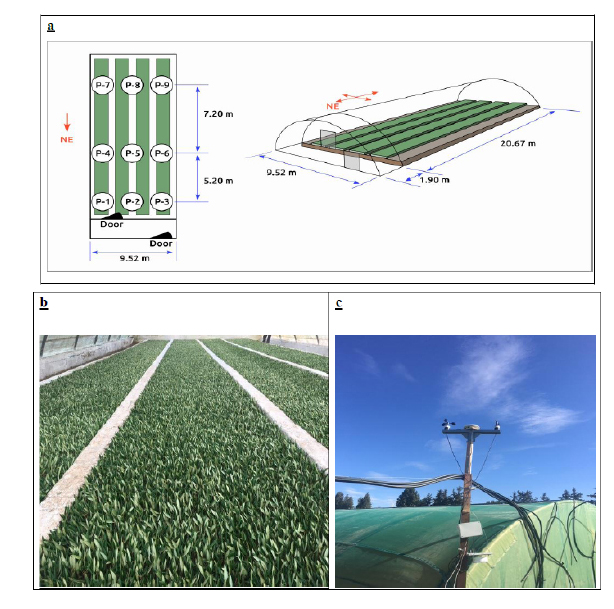
2.5. Methodology
The measurement campaign lasted for several consecutive days in January 2020.
First, to better evaluate the efficiency of the greenhouse microclimate and for the clarity and readability of the figures, we have chosen to evaluate two different cases – cloudy and sunny days of the test period – while comparing the environmental conditions created by the greenhouse and the optimal conditions for the success of the rooting process. The evaluation is based on the measured parameters (see Section 2.4), as well as the vapour pressure deficit (VPD), which was calculated according to Equations (1-3).
 |
(1) |
 |
(2) |
 |
(3) |
Next, we performed an identification regression analysis for identifying the factor and key parameters that determine the success of the rooting process, using statistical data processing SPSS software, namely T_transmis, T_int, T_sub, and the vapour pressure deficit (VPD).
The degree of interrelation between the variables was assessed by the correlation coefficient (r). This sample correlation is between -1 and 1, corresponding to perfect negative and positive linear relationships, respectively. In short, the correlation coefficient reveals relationships along the following ordinal scale: little to any correlation (0.00 ≤ |r|< 0.30), low correlation (0.30 ≤|r|≤ 0.49), moderate correlation (0.50 ≤|r|≤ 0.69), high correlation (0.70 ≤|r|≤ 0.89), and very high correlation (0.90 ≤|r|≤ 1.00). However, other nonlinear associations may also exist [15]. For example, polynomial regression illustrates a general strategy for extending linear regression so as to fit curved lines to response data [16].
The other important coefficient, r2, which is called the determination coefficient, describes the proportion of variation in the mean in one variable that is explained by the second variable. When r2 approaches unity, the response model fits the actual data better [17].
Finally, we studied the distribution of climatic parameters by analysing the average measurements recorded on 10 consecutive sunny days at each position inside the greenhouse.
3. RESULTS AND DISCUSSION
3.1. The Greenhouse Microclimate and the External Climatic Conditions
3.1.1. Solar Radiation
Fig. (2a and 2b) show the evolution of the Rg and R_transmis, respectively. The results show a significant fluctuation of low solar intensity on a cloudy day; on the other hand, on a sunny day, the global solar radiation intensity is essential and has a standard rate; its maximum value reaches 740 W/m2 and 253 W/m2 outside and inside, respectively, the greenhouse. The apical values were recorded at around 13h30.
Vegetative cuttings require a minimum quantity of light intensity for root initiation and development. Light intensity below this minimum level can stop root development or delay crop production or rooting failure. Conversely, the extremely high light intensity can reduce root formation because of excessive stress, which leaves the cuttings bleached or scorched [7]. Implementing a shading system significantly reduces plant transpiration; 50% shading allows a marked improvement in the rooting rate [18]. It can be seen that this greenhouse decreases 66% of the global solar intensity, which is an advantage of this system.

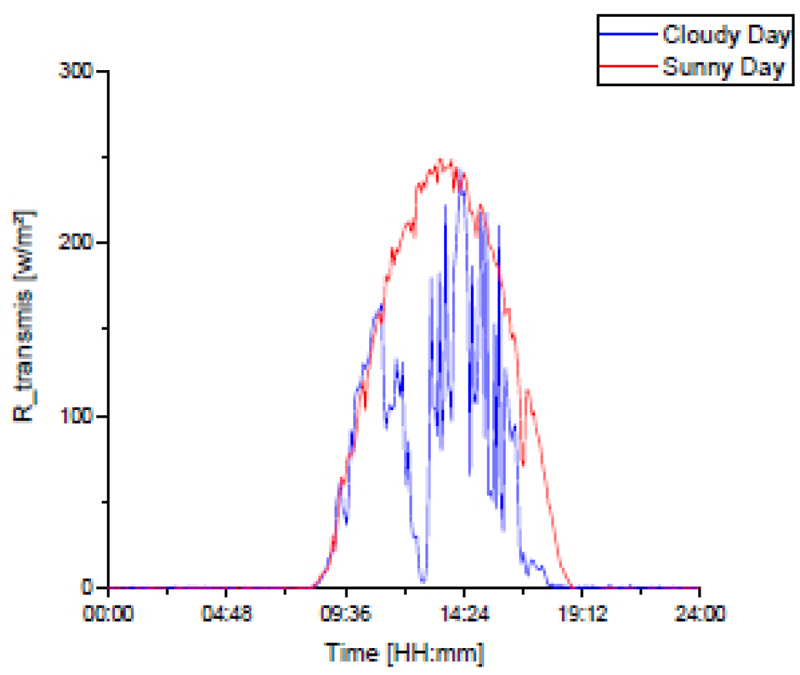
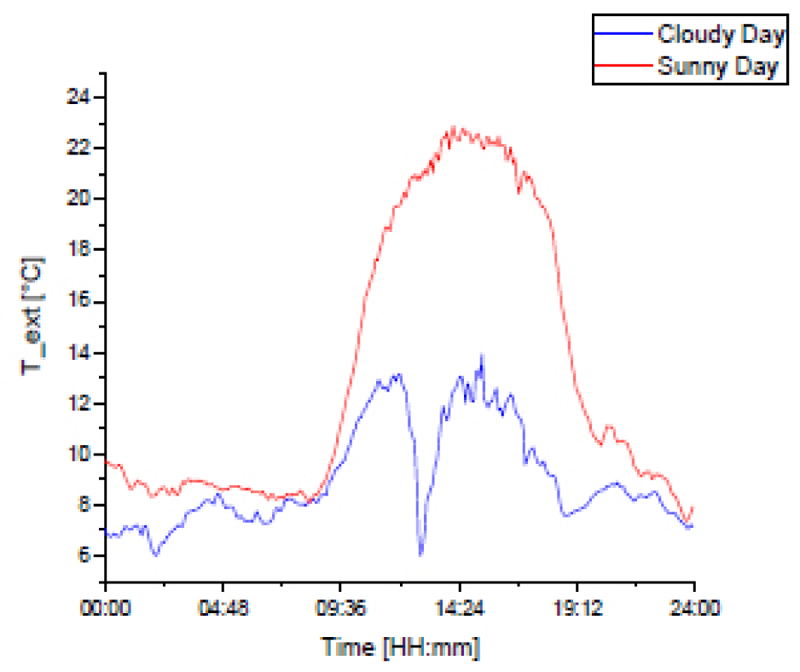
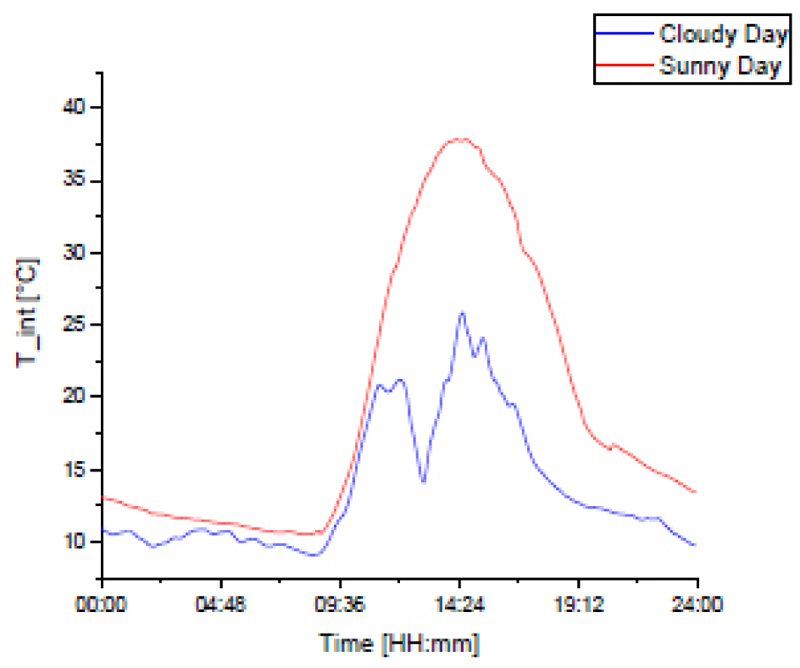
3.1.2. Air Temperature
Fig. (3a and 3b) present the temporal evolution of the T_ext and T_int, respectively. The results show a significant elevation of inside air temperature as compared to outside, irrespective of a cloudy or sunny day. During the daytime, the difference lies between 2°C and 16°C for a sunny day and between 0.8°C and 13°C for a cloudy day.
The greenhouse air temperature values range between 9°C and 25°C on a cloudy day (temperature is between 20°C and 25°C for 5 hours) and between 10°C and 38°C on a sunny day (temperature is between 20°C and 27°C for 3 hours and between 30°C and 38°C for 6 hours). However, during night-time, these values varied from 9°C to 11°C and from 10°C to 13°C on a cloudy and a sunny day, respectively.
Despite air temperature values corresponding to the root development optimal values being recorded during the daytime, its values were irregular and too high sometimes. In addition, the nighttime air temperature does not reach 14°C, which is the optimal nocturnal value for successful cuttings [19-21]. However, the studied system could not maintain optimal favourable air temperatures for the growth of young olive trees. The greenhouse's relatively high air temperatures (>27°C) would increase transpiration; moreover, axillary buds get activated, causing the leaves to drop, resulting in a significant decrease in rooting. Thus, it is necessary to use a natural ventilation system for excess heat extraction, especially on a sunny day.
3.1.3. Air Relative Humidity
Fig. (4a and 4b) present the temporal evolution of the greenhouse inside and outside relative air humidity, respectively. The results show an essential elevation of inside relative air humidity as compared to outside, irrespective of a cloudy or a sunny day. The greenhouse air recorded relative humidity values lie between 81% and 95% for a cloudy day and between 78% and 92% for a sunny one. This rise in greenhouse air humidity can be explained by the weaker greenhouse ventilation rate and the high leaves and soil evapotranspiration. The results show that the greenhouse system ensures a relative air humidity inside the greenhouse close to the saturation value (90%) and is generally stable throughout the day, which presents an advantage for the process of rooting.
3.1.4. Greenhouse Substrate Temperature and VPD
Fig. (5a) shows the temporal evolution of substrate temperature in the greenhouse (T_sub) for the two cases studied; the results indicate that the substrate temperature on a sunny day is consistently higher than on a cloudy day. This difference can reach a maximum value of 8°C. As already presented, T_sub is a crucial factor influencing the success of the rooting process; the optimal values of rooting of cuttings are recorded between 11:00 am and 8:00 pm on a sunny day, while the other hours exhibit values lower than the required ones. Therefore, a substrate heating system must be considered during these hours.
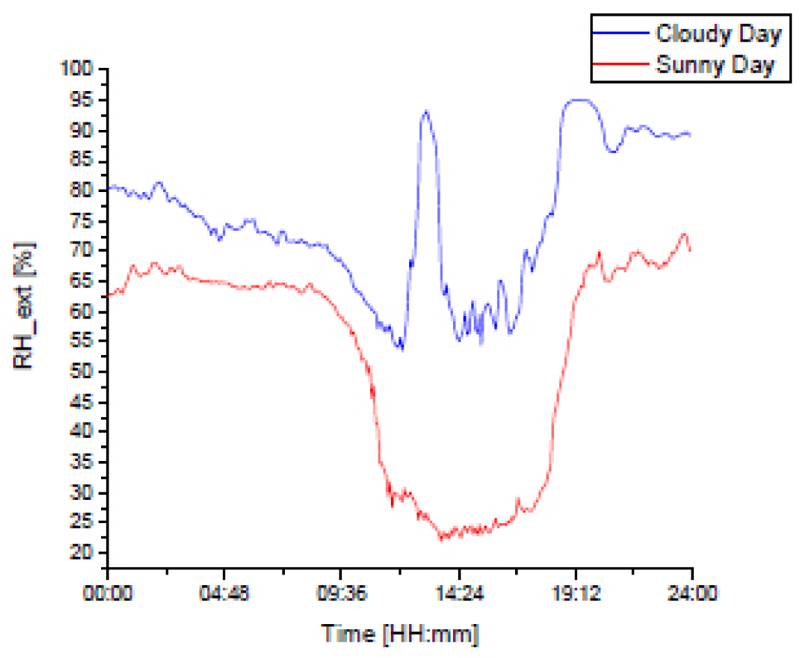
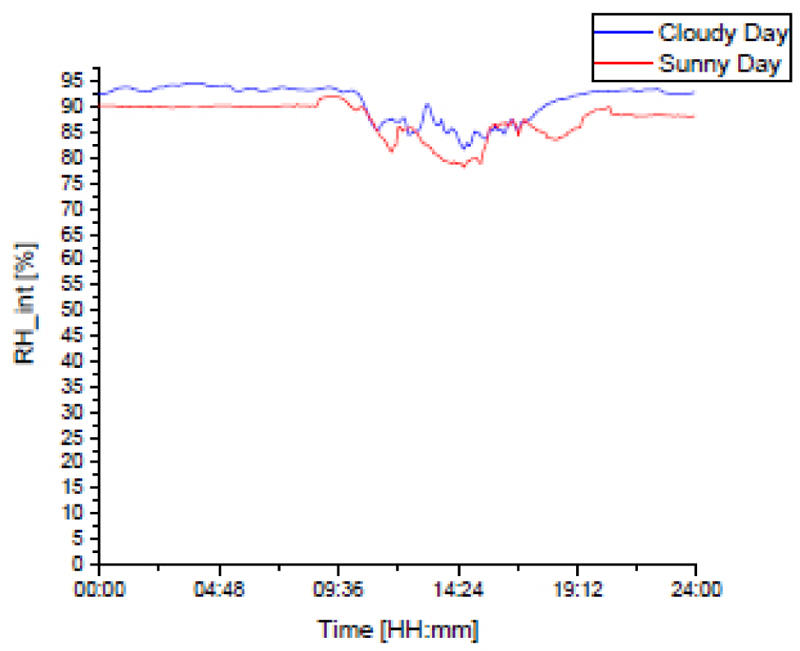

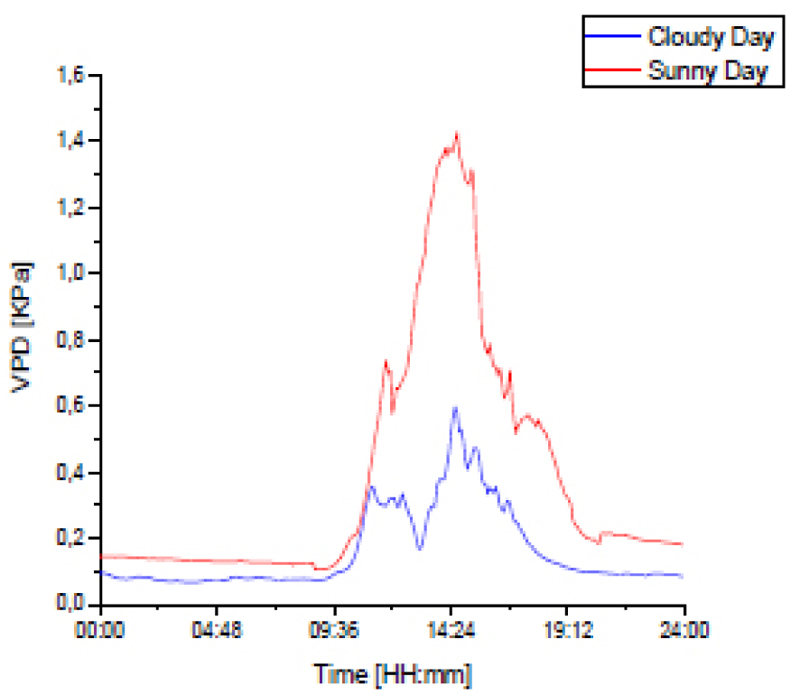
Fig. (5b) shows the temporal evolution of VPD for a cloudy and sunny day. The greenhouse VPD values are between 0.07 and 0.6 KPa for a cloudy day and between 0.10 and 1.43 KPa for a sunny one. Therefore, we can conclude that this system ensures that the VPD values are lower than 1.5 KPa for the two studied cases, and this represents an advantage for the olive cutting culture.
3.1.5. Wind Speed
Fig. (6) shows that external wind speed is a more important factor on a cloudy day than on a sunny one; its values vary between 0 and 9 m/s on a cloudy day and 0 to 3.6 m/s on a sunny day. The figure also shows that the South–West direction is more dominant on cloudy days and South on sunny days.
Wind speed is an important factor that influences the climate of the open greenhouse [22]. Still, in the case of enclosed greenhouses, studies have shown that wind has no significant direct effect on the climatic parameters of the greenhouse [23]. However, the results showed that a closed system for rooting cuttings on a cloudy day is a significant advantage due to the high wind speed values. On a sunny day, the recorded wind speed values can contribute directly to extracting excess heat from the greenhouse. Therefore, we can conclude that, to improve efficiency, the system should be equipped with ventilation openings in the East–West direction; however, the ventilation shaft should be closed during the night on sunny days and the whole day on a cloudy day.
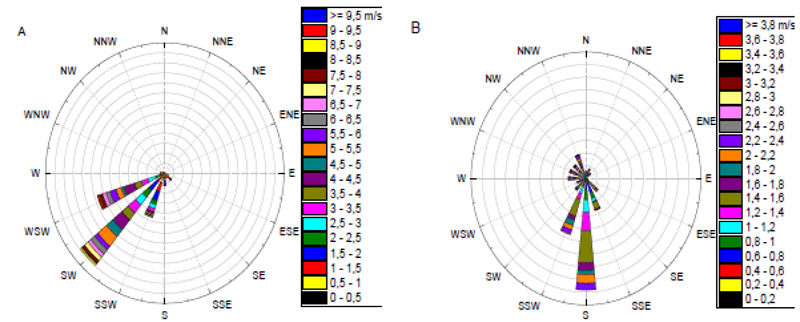
| - | - | Intercept | b | STATISTICS | ||||
|---|---|---|---|---|---|---|---|---|
| Equation | Value | Standard Error | Value | Standard error | r | r2 | Adj R-square | |
| Fig. 7a | Y = intercept+bx | -1.36 | 4.31 | 0.34 | 0.01 | 0.97 | 0.94 | 0.94 |
| - | - | Intercept | B1 | B2 | STATISTICS | ||||
|---|---|---|---|---|---|---|---|---|---|
| Equation | Value | Standard Error |
Value | Standard Error |
Value | Standard error | R-square | Adj R-square |
|
| Fig. 7b | Y = intercept +B1*x+B2*x2 | 10.14 | 0.26 | 0.0084 | 0.0017 | 4.32E-5 | 2.24E-6 | 0.96 | 0.96 |
| Fig. 7c | Y = intercept +B1*x+B2*x2 | 13.68 | 0.18 | -0.0029 | 0.0012 | 2.59E-5 | 1.58E-6 | 0.90 | 0.90 |
| Fig. 7d | Y = intercept +B1*x+B2*x2 | 13.68 | 0.18 | -0.0029 | 0.0012 | 2.59E-5 | 1.58E-6 | 0.90 | 0.90 |
3.2. Statistical Analysis
This study shows that solar radiation is a factor determining the greenhouse microclimate. Therefore, we have highlighted the regression relationships between this factor and the critical parameters of the rooting process, namely T_transmitted (Fig. 7a), T_int (Fig. 7b), T_sub (Fig. 7c), and VPD (Fig. 7d).
Analysing these results, we noticed that the R_tranmis is positively correlated with the Rg, with the correlation coefficient (r) reaching a high value of 0.97 (Table 2). Also, there is a polynomial relationship among Rg and T_int T_sub and VPD, with the correlation determination value reaching 0.96, 0.90, and 0.90, receptively (Table 2). This statistical study confirmed that solar radiation is a factor determining the climate variables inside the greenhouse. These equations will allow the prediction of the greenhouse climate from global solar radiation.
3.3. Effect of the Delta 9 Greenhouse on the Homogeneity of the Greenhouse Microclimate
Fig. (8a) shows the average temperature measured during the test period, which shows a temperature difference of up to 2°C at 10:30 am up to 4°C at 2:30 pm, as well as up to 1.5°C for the other times. The results indicate that the spatial distribution of T_int was affected by external solar radiation. These results are in agreement with the findings of Ahmed, H. A.et al. (2019) [11].
Figure 8.b shows that the most important temperature gradient, that is, the difference between the temperatures of air and the leaf, is recorded at 02:30 pm; this difference is about 6.5°C. However, at other hours, the difference is between 0.69°C and 1.8°C. This difference is related to the increase in transpiration, which is related to the intensity of solar radiation [24]. Further, the evaporative cooling system used can also affect the results.
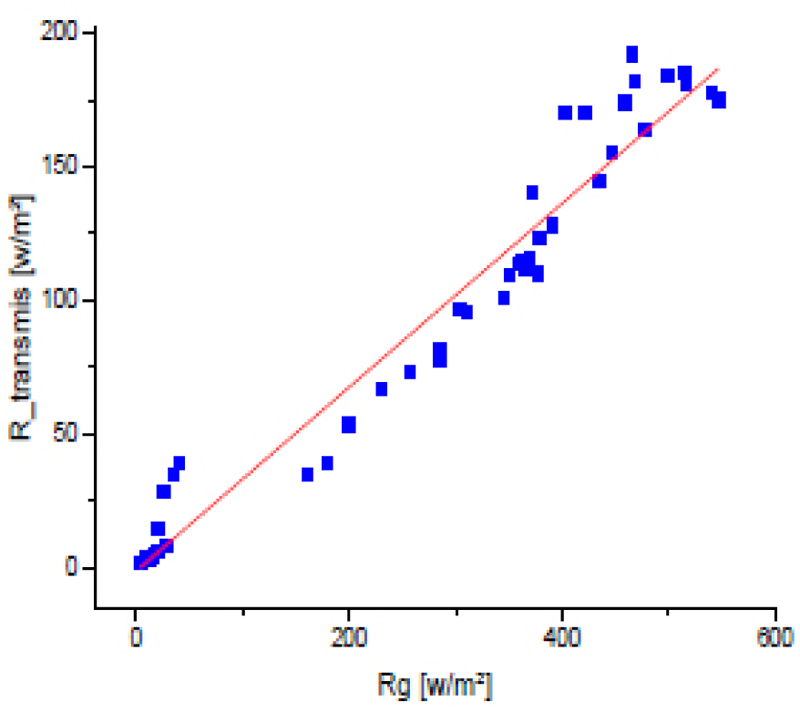

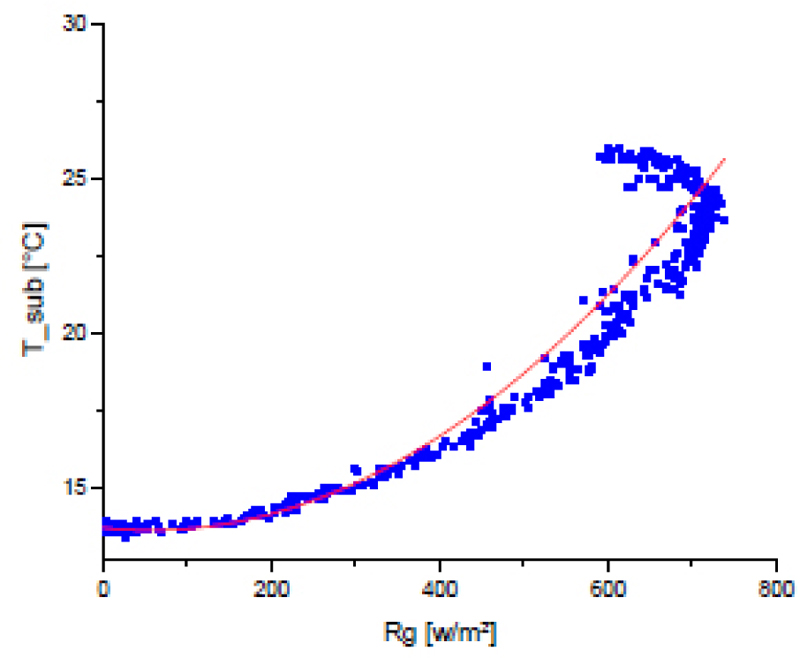
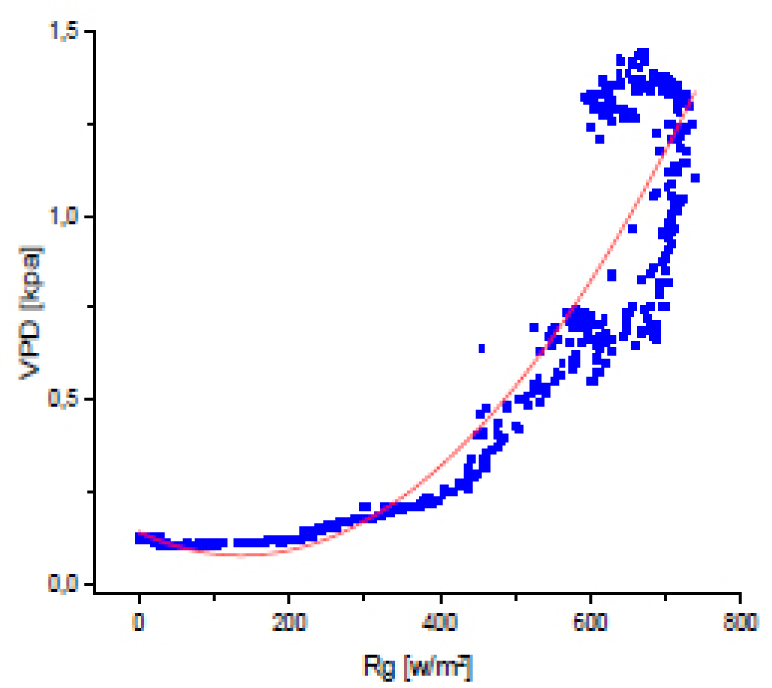
Fig. (8c) shows a difference of less than 1°C at 02:30, 06:30, 10:30, and 22:30 between the average values measured between the two positions. However, this difference is of the order of 4°C at 02:30 pm and 1.65°C at 06:30 pm. This remarkable difference at 2:30 pm can be linked to the solar intensity and the cooling system.
Fig. (8d) shows that the humidity level in the greenhouse does not vary much between one position and another; this variation reaches 11% at 02:30 pm and does not exceed 8% at other times. This shows that the humidity, in this case, is not directly related to solar radiation but depends on the evapotranspiration from plants and humidification from the cooling system used.
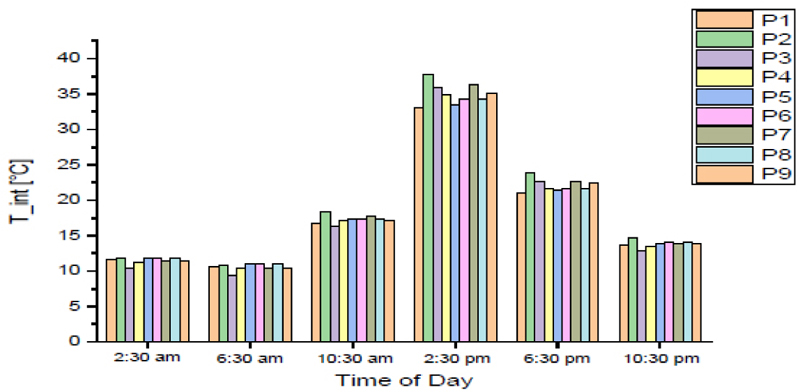
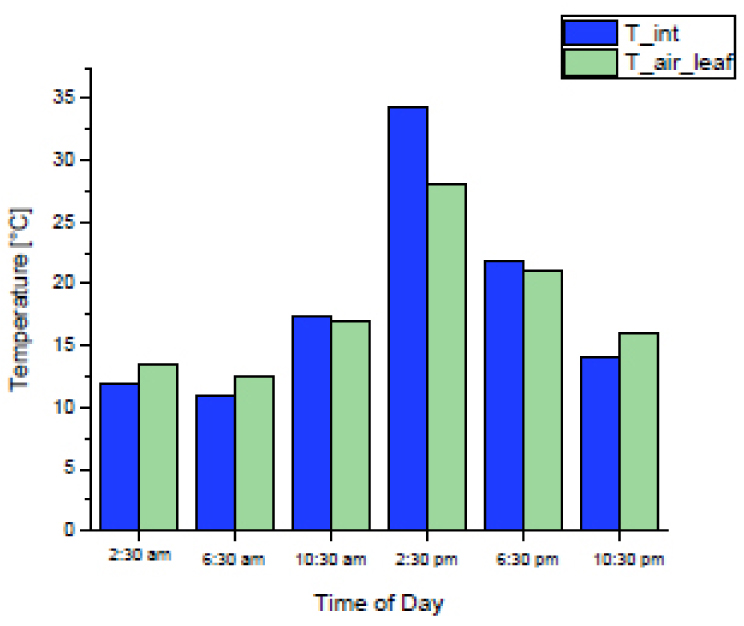
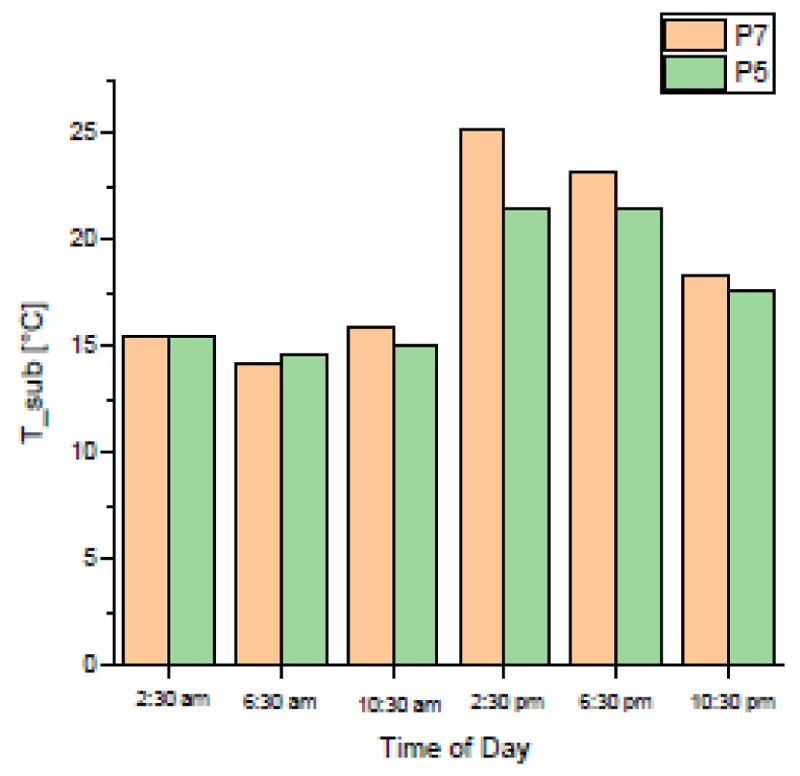
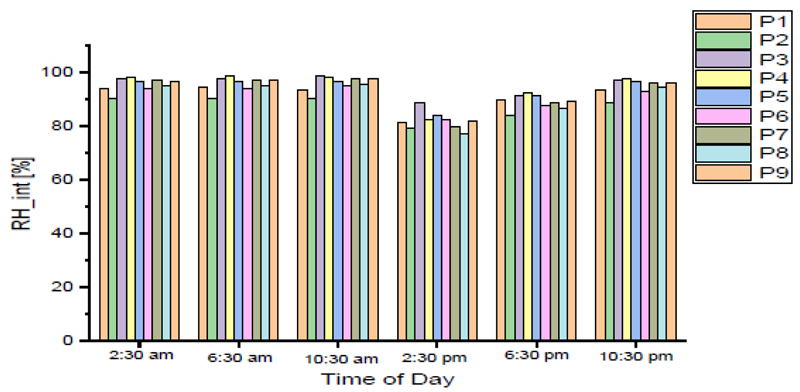
Despite the noticeable effect of solar radiation on the spatial distribution of certain climatic parameters inside the greenhouse, the results of the present study allow us to conclude that there is an overall homogenization of the climatic parameters inside the greenhouse. Studies focusing on crop-growing conditions have shown significant differences in air temperature vertically and horizontally within greenhouses. These studies measured vertical differences in temperatures of about 7–14°C and horizontal differences of about 6–8°C [25]. For relative humidity, the study found a difference of 10–40% [26]. So, this study showed the ability of this type of greenhouse to, more or less, guarantee a homogeneous microclimate inside the greenhouse, which is beneficial for the rooting of cuttings.
4. CONCLUSION
This study presents a global characterization of the microclimate of a tunnel greenhouse for olive cuttings. The results obtained allowed us to evaluate the impact of this type of greenhouse on the process of rooting cuttings. This greenhouse system significantly reduces the global solar radiation inside the greenhouse by up to 66%, which is an advantage for this crop. The statistical study confirms that solar radiation is a determining factor of the climate variables inside the greenhouse. Also, the study demonstrates that this type of greenhouse provides adequate relative humidity (78–95%) and VPD values (0.07–1.43 KPa) for the two studied cases (sunny and cloudy days) for the success of the rooting process. This study showed the ability of this type of greenhouse to, more or less, guarantee a homogeneous microclimate inside the greenhouse, that is, average spatial differences for temperature and humidity, which is beneficial for the rooting of cuttings. On the other hand, the results showed that the system produces excess heat between 12 pm and 2 pm, despite the use of two cooling systems, especially on sunny days; hence, this greenhouse must be equipped with natural ventilation openings and a thermal curtain under the roof covering to save heat at night. The results of this study may be useful for future research to validate a computational fluid dynamics (CFD) model developed for studying different greenhouse designs for the development of root cuttings.
NOMENCLATURE
T_int: Greenhouse inside air temperature (°C)
T_ext: Greenhouse outside air temperature (°C)
T_sub: Greenhouse substrate temperature (°C)
T_air_leaf: Greenhouse inside air leaf temperature (°C)
RH_int: Greenhouse inside relative humidity (%)
RH_ext: Greenhouse outside relative humidity (%)
Rg: Global solar radiation (W/m2)
R_transmis: Solar radiation transmitted into the greenhouse (W/m2)
VPD: Vapour pressure deficit in the greenhouse (KPa).
WD: Wind direction (degree).
WS: Wind speed (m/s)
ETHICS APPROVAL AND CONSENT TO PARTICIPATE
Not applicable.
HUMAN AND ANIMAL RIGHTS
Not applicable.
CONSENT FOR PUBLICATION
Not applicable
AVAILABILITY OF DATA AND MATERIALS
Not applicable.
FUNDING
None
CONFLICT OF INTEREST
The authors declare no conflict of interest, financial or otherwise.
ACKNOWLEDGEMENTS
We are grateful and indebted to many members of the nursery teams who helped us with the tremendous amount of practical work, thereby enabling us to carry out this study successfully.


